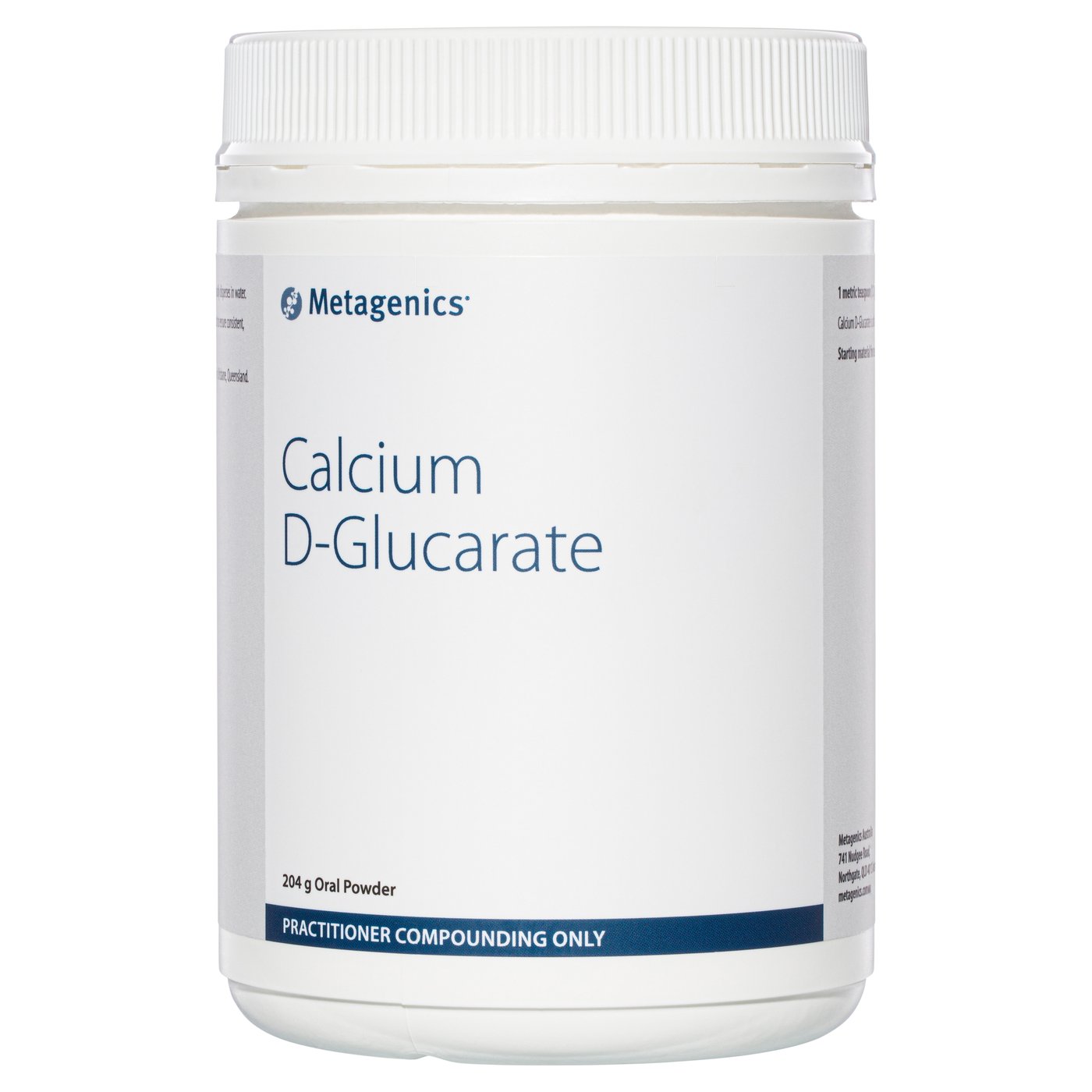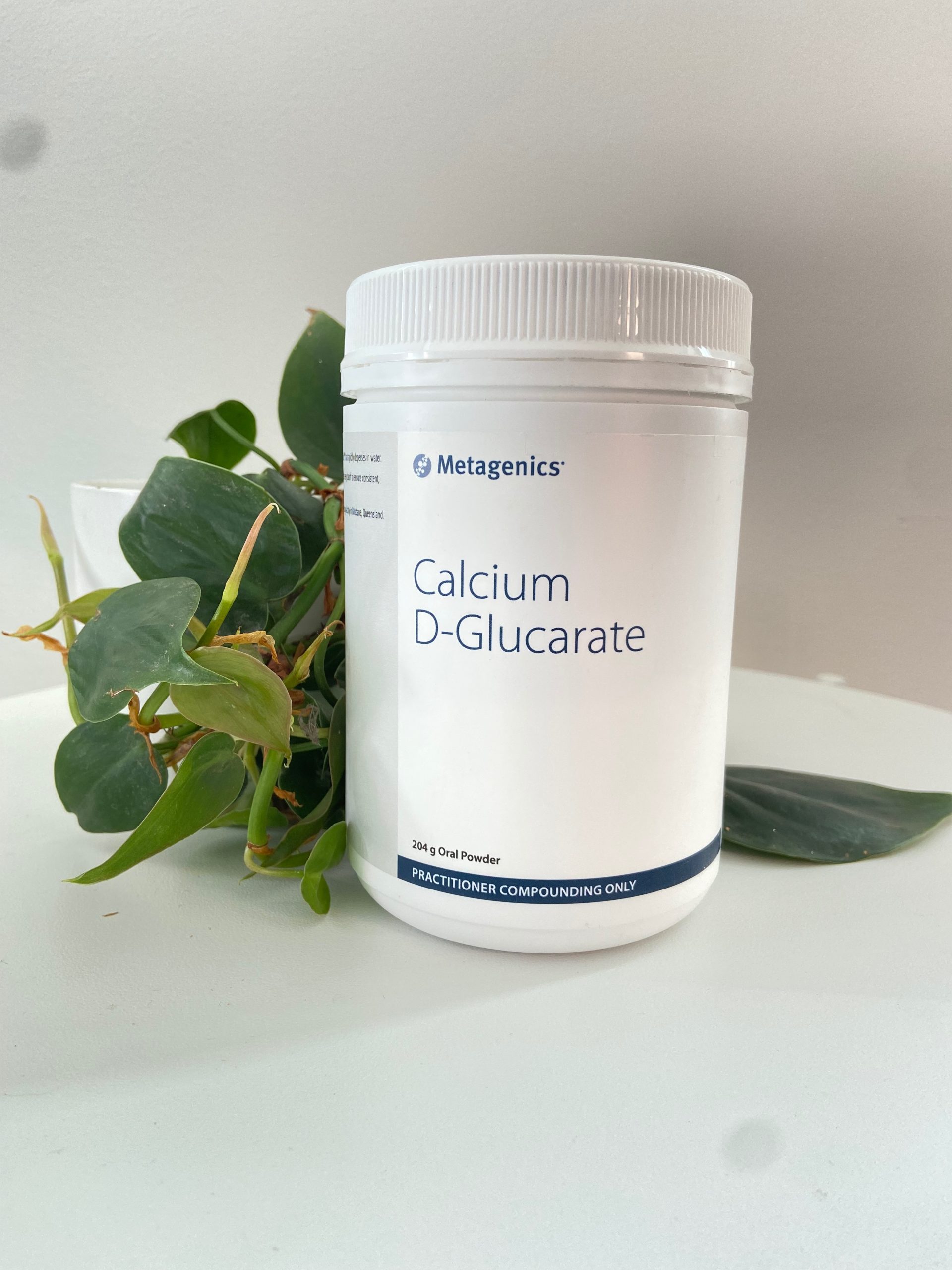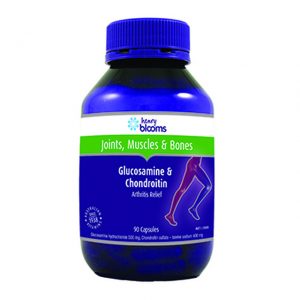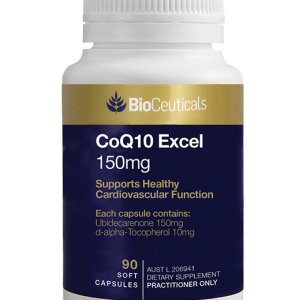Metagenics – Calcium D Glucarate
Assist Glucuronidation For Oestrogen and Xeno-Oestrogen Detoxification
The Metagenics range is practitioner prescribed only. Enquire at hi@zhongcentre.com
Metagenics Calcium D-Glucarate Size: 240g
Metagenics Calcium D-Glucarate:
- Glucuronidation is a key phase II process that assists in the detoxification of oestrogen and xeno-oestrogen compounds from the environment.
- Metagenics Calcium D-glucarate is a natural glucose metabolite which is an effective inhibitor of β-glucuronidase – an enzyme which deconjugates bound toxins and other metabolic waste products.
- By preventing deconjugation of products of glucuronidation, calcium D-glucarate promotes a net increase in phase II detoxification and is indicated in toxicity-associated conditions, especially those involving excessive oestrogen activity.
Directions: Metagenics Calcium D-Glucarate
Oestrogen/xeno-oestrogen detoxification: 1500-3000 mg daily (1-2 tsp)
Cancer: 1500-3000 mg daily (1-2 tsp)
Gallstones: 1500-3000 mg daily (1-2 tsp)
Dyslipidaemia: 1500-3000 mg daily (1-2 tsp)
1 metric tsp (1.69 g) is equal to 1.50 gram of Calcium D-Glucarate (Calcium D-Glucarate) Stir well and take immediately.
Benefits: Metagenics Calcium D-Glucarate
Clinical Benefits: Metagenics Calcium D-Glucarate
- Calcium D-glucarate is a natural glucose metabolite which is an effective inhibitor of β-glucuronidase – an enzyme which deconjugates bound toxins and other metabolic waste products. Glucuronidation is a key phase II process that assists in the detoxification of oestrogen and xeno-oestrogen compounds from the environment.
- By preventing deconjugation of products of glucuronidation, calcium D-glucarate promotes a net increase in phase II detoxification and is indicated in toxicity-associated conditions, especially those involving excessive oestrogen activity.
Ingredients: Metagenics Calcium D-Glucarate
Calcium D-Glucarate
Warnings: Metagenics Calcium D-Glucarate
Not all cautions and contraindications are listed. For full details, references or more information contact HealthMasters in Australia by email: reception@healthmasters.com.au
Storage: Metagenics Calcium D-Glucarate
Store below 30° C
Technical Information: Metagenics Calcium D-Glucarate
Calcium D-Glucarate
Calcium D-glucarate is a natural glucose metabolite which is an effective inhibitor of β-glucuronidase – an enzyme which deconjugates bound toxins and other metabolic waste products. Glucuronidation is a key phase II process that assists in the detoxification of oestrogen and xeno-oestrogen compounds from the environment. By preventing deconjugation of products of glucuronidation, calcium D-glucarate promotes a net increase in phase II detoxification and is indicated in toxicity-associated conditions, especially those involving excessive oestrogen activity.
HERBS AND NUTRIENTS THAT MAY ASSIST
Calcium D-glucarate
CLINICAL APPLICATIONS
KEY ACTIONS:
- Inhibits β-glucuronidase and increases net phase II glucuronidation
- Decreases oestrogen
- Anticarcinogenic
- Improves lipid and bile metabolism
- Anti-inflammatory
- Antioxidant
KEY APPLICATIONS:
- Oestrogen/xeno-oestrogen dependent conditions
- Cancer, especially breast and prostate
May also be considered for:
- Gallstones
- Dyslipidaemia
DOSES
- Oestrogen/xeno-oestrogen detoxification: 1500-3000 mg daily (1-2 tsp)
- Cancer: 1500-3000 mg daily (1-2 tsp)
- Gallstones: 1500-3000 mg daily (1-2 tsp)
- Dyslipidaemia: 1500-3000 mg daily (1-2 tsp)
BACKGROUND TECHNICAL INFORMATION
Glucuronidation
Glucuronidation is an important phase II detoxification process which attaches glucuronic acid to a toxin for excretion. Glucuronic acid serves as conjugation compound for the detoxification of a wide variety of endogenous and exogenous substrates, including sex hormones and toxins.1,2 In glucuronidation, the enzyme uridine 5'-diphospho-(UDP)-glucuronosyltransferase (UDG) attaches the water-soluble glucuronic acid to the more fat-soluble substrate, creating a conjugate compound which is now water-soluble for elimination.
β-glucuronidase
The enzyme β-glucuronidase reverses the process of glucuronidation; deconjugating the glucuronic acid from the toxin and ‘re-activating’ it, as it is no longer bound. The amount of a toxin that is eliminated is believed to be largely determined by the balance of conjugation versus deconjugation (Figure 1).

Figure 1. Glucuronidation and deglucuronidation of toxins.
The net amount of toxin detoxified is determined by the balance between conjugation via uridine 5'-diphospho—glucuronosyltransferase (UDG) and deconjugation from β-glucuronidase (BG).
Humans synthesise β-glucuronidase and it has been detected in many tissues including liver, kidney, spleen, testes, lung, gastrointestinal tract, and in cancerous and inflamed tissue. Additionally, a dysbiotic gastrointestinal microbiome produces high levels of β-glucuronidase, which can act identically to human β-glucuronidase, by deconjugating glucuronidated substances.4
Essentially, almost any tissue and body compartment can deconjugate glucuronidated compounds and restore their bioactivity via β-glucuronidase.
β-glucuronidase is believed to have a constitutive role in degrading glycosaminoglycans for tissue remodelling. However, as is the case with many inflammation-induced mediators, down-regulating excessive levels is a useful short or long term strategy in the control of disease, with little risk of compromising normal physiology. Elevated levels of β-glucuronidase have been found in various pathologies and inflammatory disorders, with elevated levels linked to cancer risk.5,6,7 β-glucuronidase levels are naturally suppressed by compounds found in a healthy diet (described below); indicating that control of β-glucuronidase activity can be considered an normal and safe strategy to restore homeostasis in situations of dysbiosis and inflammation.
INGREDIENTS
Calcium D-glucarate is glucose-like compound, which upon ingestion is metabolised in the stomach to form D-glucaric acid. D-glucaric acid can be obtained from the diet from plant foods, most notably in grapefruits, apples, oranges and cruciferous vegetables. A diet high in fruits and vegetables is estimated to provide around 200 mg/day of D-glucaric acid.8 Additionally, humans can synthesis small amounts of D-glucaric acid in the liver from glucose.9
Calcium D-glucarate, and the resulting D-glucaric acid, are further metabolised to create D-glucaro-1,4-lactone (1,4-GL), which has been shown to be the active form of supplemental calcium D-glucarate (Figure 2).10
 Figure 2. The metabolism of calcium D-glucarate to the bioactive compound D-glucaro-1,4-lactone.
Figure 2. The metabolism of calcium D-glucarate to the bioactive compound D-glucaro-1,4-lactone.
1,4-GL acts to attenuate the deconjugation of products of glucuronidation by inhibiting β-glucuronidase and thus allow the toxin to be eliminated successfully.11
ACTIONS
INHIBITS β-GLUCURONIDASE AND INCREASES NET PHASE II GLUCURONIDATION
The key mechanism of action of calcium D-glucarate is inhibition of β-glucuronidase. Calcium D-glucarate therefore has the potential to mitigate deconjugation of glucuronidated compounds, such as oestrogen, and promote safe excretion of the conjugated substance.12,13,14,15
The ability of calcium D-glucarate to inhibit β-glucuronidase was first demonstrated over sixty years ago and numerous studies since have confirmed its ability. For example, feeding rodents a single dose of calcium D-glucarate results in significant inhibition in β-glucuronidase in several sites, including serum, liver, lung and intestine (Figure 3).16 The activity of β-glucuronidase has been found to be elevated in many disease states, including numerous types of cancers, diabetes, heart disease, rheumatoid arthritis, liver pathology, cholelithiasis, inflammation, jaundice, tuberculosis, and sarcoidosis.17,18

Figure 3. The effect of calcium D-glucarate (CDC) on β-glucuronidase activity in several tissues.19
* p<0.05 compared to control
DECREASES OESTROGEN
Inhibition of β-glucuronidase with calcium D-glucarate can allow more substrate to remain conjugated, with a net change of increasing phase II detoxification.20 For example, rats showed a 23% reduction in serum oestradiol and a 55% reduction in oestrone levels when fed calcium D-glucarate (Figure 4).21

Figure 4. Percentage reduction in serum oestradiol and urinary oestrone in rats feed calcium D-glucurate. 22
ANTICARCINOGENIC
Inhibiting β-glucuronidase is considered to be a key mechanism in calcium D-glucaric acid’s anticarcinogenic effect. It is suggested that calcium D-glucarate’s action is largely due to its ability to detoxify hormones and exogenous toxins that are linked to carcinogenesis. Environmental carcinogens and endogenous oestrogens can cause DNA mutations and promote tumourigenesis; therefore promoting of glucuronidation of these toxins can reduce the carcinogenic load.23 Additionally, tumours contain high levels of β-glucuronidase which is linked to inflammation and subsequent metastasis, with researchers suggesting inhibition of β-glucuronidation may attenuate inflammation and metastasis.24,25
Outside of inhibiting β-glucuronidase, calcium D-glucarate has several other anti-carcinogenic actions. It inhibits protein kinase-C activity and induces transforming growth factor β, which can result in an increase in cellular differentiation and regulate progression through the cell cycle. Calcium D-glucarate has also been found to synergistically interact with retinoids and powerfully inhibit carcinogenesis in animal models.26
IMPROVES LIPID AND BILE METABOLISM
Evidence shows that calcium D-glucarate administration reduces serum cholesterol levels, with research suggesting that it may be modulating steroidogenesis.27 Additional research suggests that calcium D-glucarate is useful for promoting healthy bile flow. β-glucuronidase in the biliary tract can deconguate bile salts, such as bilirubin, which can allow gallstones to precipitate.28 Mice receiving 1,4 GL showed a decrease in the biliary β- glucuronidase activity, indicating a reduction of bile deconjugation.29
ANTI-INFLAMMATORY
Recent evidence shows that 1,4-GL has an anti-inflammatory effect independent of its β-glucuronidase inhibiting action. 1,4-GL was found to inhibit key intercellular inflammatory mediators such as protein kinase C and nuclear factor kappa B.30
ANTIOXIDANT
Several recent studies have demonstrated that calcium D-glucarate has a potent antioxidant activity, also independent of inhibition of β-glucuronidase. Saluk-Juszczak et al found that 1,4-GL had a significant antioxidant activity against oxidative damage to lipids and proteins of platelets, induced by very strong oxidants, such as reactive nitrogen species and reactive oxygen species.31 Similarly, Rashid et al found 1,4- GL reduced oxidative stress and improved glutathione status in mice administered the diabetes-inducing compound alloxan.32
APPLICATIONS
OESTROGEN / XENO-OESTROGEN DEPENDENT CONDITIONS
A number of female reproductive conditions are linked to elevated systemic and/or tissue levels and/or elevated environmental chemicals (“xeno-oestrogens”) (Table 1). The high levels of oestrogens and xeno-oestrogens are thought to contribute to the pathology, through such mechanisms as increasing inflammation, promoting undifferentiated growth and causing DNA damage. One strategy to treat oestrogen/xeno-oestrogen dominant conditions is to promote detoxification and subsequently reduce body levels of these compounds.
The use of calcium D-glucarate can be viewed as one tool for reducing oestrogen/xeno-oestrogen levels by promoting net glucuronidation.
Table 1. Female reproductive conditions associated with oestrogen and/or xeno-oestrogen excess. 33,34,35,36,37,38,39
| Elevated tissue or serum concentration of oestrogen found in: | Elevated xeno-oestrogens linked to: |
|
|
Glucuronidation may be impaired in hypothyroidism40 and supporting glucuronidation may assist in oestrogendominant conditions where hypothyroidism is contributing. Clinically, this may be seen in patients presenting with conditions such as endometriosis, fibroids and fibrocystic breast disease.
CANCER
Numerous studies have identified increased levels of β-glucuronidase, either in the affected tissue or in the serum (Figure 5), in people with tumours.41,42 Table 2 lists the types of cancers found to be associated with elevated β-glucuronidase. Numerous animal studies have shown that oral administration of calcium Dglucarate decreases initiation, promotion and progression of experimental tumours induced by a variety of carcinogens.43 The results of animal studies have led researchers to suggest that that calcium D-glucarate may reduce the risk of lung, breast, prostate, liver, skin, and colon cancer in humans. 44

Figure 5. Serum levels of β-glucuronidase in breast cancer patients compared to controls. 49
Table 2. Tumour types associated with elevated β-glucuronidase. 45,46,47,48
|
|
GALLSTONES
Several lines of evidence support the use of calcium D-glucarate for the management of gallstones (cholelithiasis). β-glucuronidase activity in the liver and bile duct is suspected to play a pathogenic role in the condition by deconjugating glucuronidated bilirubin.50,51 One study found that people with cholesterol gallstones (the more common form) or pigment gallstones had 11- and 33-fold greater level of biliary β-glucuronidase than healthy controls, respectively. An animal study investigating the effect of 1,4 GL on bile function found that it significantly lowered biliary β-glucuronidase activity.52
DYSLIPIDAEMIA
Preliminary results investigating the lipid lowering effect of calcium D-glucarate found that it reduced total serum cholesterol up to 12 percent, LDL cholesterol up to 28 percent, and triglycerides up to 43 percent. The researchers suggests calcium D-glucarate lowered cholesterol by increasing excretion of bile acids. 53
CAUTIONS AND CONTRAINDICATIONS
CONTRAINDICATIONS
- Digoxin: This drug is metabolised via glucuronidation and therefore levels may be affected by calcium-Dglucarate supplementation. Only use this combination under medical supervision.54,55,56,57
CAUTIONS
Diazepam/oxazepam: This drug is metabolised via glucuronidation and therefore levels may be affected by calcium-D-glucarate supplementation. Use with caution in patients taking this medication and monitor symptom changes. 58,59,60,61
Oral contraceptives: Calcium D-glucarate may reduce the efficacy of oral contraceptives. Calcium Dglucarate may impact on the metabolism and elimination of oestrogen via an action on beta-glucuronidase. Barrier forms of contraception may be required.62,63,64,65
PREGNANCY AND BREASTFEEDING
Pregnancy: Discontinue use if patient becomes pregnant whilst taking this formula. Oestrogen detoxification should be avoided during pregnancy.66,67
Breastfeeding: Likely safe when used at recommended doses.68,69
Additional information
| Weight | 204 g |
|---|---|
| Brand | NATUROBEST |
Only logged in customers who have purchased this product may leave a review.









Reviews
There are no reviews yet.